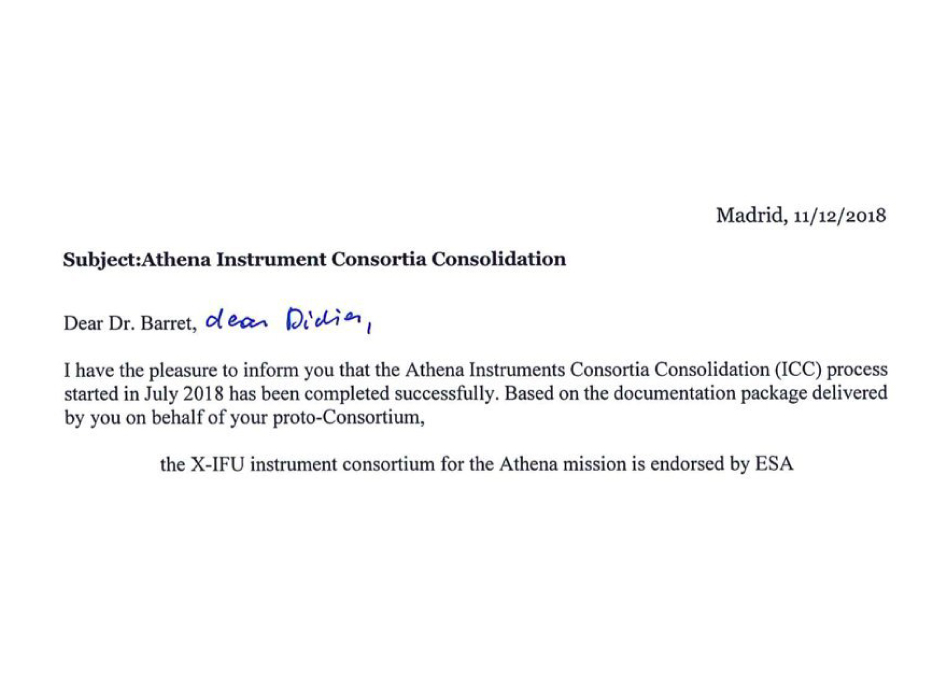
Date.
On the 11th of December 2018, exactly two years ago today, I received a letter from the ESA Director of Science, Günther Hasinger, stating:
“I have the pleasure to inform you that the Athena Instrument Consortia Consolidation process, started in July 2018, has been successfully completed. Based on the document provided by you on behalf of your proto-Consortium, the X-IFU instrument consortium for the Athena mission is endorsed by ESA in the structure and with the composition described in the provided documentation”.
Announcing the news to the Consortium, I wrote:
“This is a remarkable achievement, which demonstrates that ESA has gained confidence that we, as an international consortium, can deliver the great instrument that is X-IFU. This wouldn’t have been possible without your unfailing support from day one. So, let me thank you deeply for contributing to this success. This milestone behind us, let us now focus all our efforts on the upcoming Preliminary Requirement Review”.
And indeed, the next big thing to come was the Instrument Preliminary Requirement Review (IPRR). It was a rather intensive effort from the whole team. It started in January and on the 4th of November 2019, a board meeting held at ESTEC declared the X-IFU IPRR successful, with actions identified to pave the way to the Athena Mission Formulation Review (MFR) and beyond. A few days later, the MFR was also declared successful allowing Athena to move to its definition phase.
2020 will be remembered as the year of the pandemic, but for X-IFU, it was also the year in which two major programmatic and technical changes were implemented to put the instrument development on a safer path. The first one consisted in transferring the X-IFU cryostat and the cooling chain to the industry. It will now be provided under ESA responsibility by the industrial Prime which will build the Science Instrument Module of Athena. At the moment the Science Instrument Module and the X-IFU cryostat and cooling chain are studied by two Primes in competition (Airbus Defence and Space and Thalès Alénia Space).
The second change implemented early 2020 was the switch of the X-IFU detection readout scheme to Time Domain Multiplexing. The risk of not meeting the spectral resolution and field of view requirements and the risk induced by the system complexity was considered higher for Frequency Domain Multiplexing, our previous baseline, than it was for Time Domain Multiplexing readout.
As we speak, these two changes are being implemented with the objective of being able to support the upcoming reviews. The Intermediate Review is planned for April 2021 and the X-IFU System Requirement Review foreseen for September/October 2021, pending on the Primes ability to advance sufficiently on the cryostat design.
A new consortium organisation is now in place in support of these activities. It is under the leadership of Vincent Albouys, the CNES project manager appointed in March 2019 to succeed to Thien Lam Trong who had conducted X-IFU through a successful IPRR. The organisation is based on joint CNES and Consortium working groups, as well as regular reporting through various project level meetings.
The pandemic has changed our approach to virtual meetings with well identified pros and cons. While many of us feel the need for physical meetings, this will have a clear positive impact on reducing the travel footprint of X-IFU; an initiative launched before the pandemic that has received broad support within the Consortium. This is yet another achievement that we should also be collectively proud of.
To conclude, two years after the endorsement of the X-IFU Consortium by ESA, with a successful IPRR, changes in both the cryostat procurement scheme and in the detection readout scheme, as well as progresses made in many corners of the project, everything indicates that we have the capabilities and the right organisation to achieve the challenge of building the X-IFU for Athena, giving back to ESA the trust they placed in us.
Didier Barret
X-IFU Principal Investigator


 Youtube
Youtube